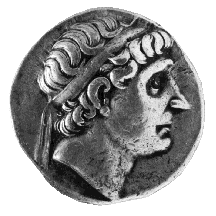



(50) Syria, Antiochos I Soter - AR tetradrachm, c. 264
B.C., 17.17 g. (inv. 91.090).
Obverse: Diademed head of Antiochos r.
Reverse: Apollo seated on omphalos l., holding arrow in r., with l. resting
on bow and quiver resting against omphalos; monograms in l. and r. fields;
![]()
![]() : of King Antiochos.
: of King Antiochos.
Provenance: Hesperia Art, 1960.
Bibliography: O. Mørkholm, Early Hellenistic Coinage from the
Accession of Alexander to the Peace of Apamea (336-188 B.C.) (Cambridge
1991) 116.
Antiochos I of Syria succeeded his father, Seleukos I, the founder of the
Seleukid dynasty, in 280 B.C. at the age of forty-four. Despite constant
revolts and wars throughout his reign, he managed to secure his position
and keep the kingdom intact. A great victory over the Galatians in 276 B.C.
earned him the title Soter or Savior. He was defeated by Eumenes I of Pergamon
in 262 B.C. and died in 261 B.C.
Antiochos originally retained the old Alexander types on his coins, but
he soon began issuing tetradrachms with his own portrait on the obverse.
Although the head retains some aspects of Alexander's portrait type, particularly
in the arrangement of the hair, it appears to be a realistic portrait of
an older man, with emphasis on his deep-set eyes, sharp nose, and pursed
lips.
The depiction of Apollo on the reverse initiates the most common Seleukid
reverse type. Although he had not put Apollo on his own coins, Seleukos
I had established him as the patron deity of the Seleukid dynasty by building
a grand shrine to Apollo at Daphni, near the capital, Antioch. The omphalos
is criss-crossed with ribbons and refers to the sacred stone of the sanctuary
of Apollo at Delphi that marked the center of the earth. The god holds his
attributes, the bow and arrow, and seems to be testing the arrow in his
right hand. These coins were issued by the mint at Seleucia-on-the-Tigris,
and the types were continued under Antiochos II.
K.J.B.



All contents copyright (c) 1996.
Lawrence University
All rights reserved.